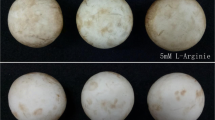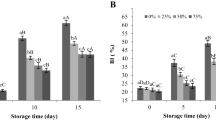Abstract
In order to extend the storage life of button mushrooms (Agaricus bisporus), glycine betaine (GB) treatment was introduced and its effect on the quality and physiological characteristics of button mushrooms during storage was evaluated in the present work. Fresh button mushrooms were soaked with GB solutions of different concentrations and then stored at low temperature (2 °C) for 12 days. The variations of weight loss rate, percent open caps and color of mushrooms were investigated. Physiological characteristics were evaluated during storage, including respiration rate, polyphenol content, malondialdehyde accumulation as well as activities of polyphenol oxidase enzyme (PPO) and antioxidant enzymes. Membrane permeability and microstructure was also analyzed by electrical conductivity and scanning eletron microscope (SEM) measurement. The results showed that the button mushrooms treated with GB kept a lower level of weight loss and respiration rate, the cap opening and browning were also inhibited. Meanwhile, treated samples maintained high content of polyphenol and ascorbic acid and showed better integrity of cell membrane structure. In addition, GB inhibited PPO activity and improved activities of antioxidant enzymes such as SOD, POD and CAT during storage period. The results of treatment group with 2 mM GB were significantly better with other treatment groups (p < 0.05), which was determined to be the suitable treatment concentration of GB to extend the storage life of button mushrooms.






Similar content being viewed by others

References
Beelman RB, Royse DJ, Chikthimmah N (2003) Bioactive components in button mushroom Agaricus bisporus (J. Lge) imbach (Agaricomycetideae) of nutritional, medicinal, and biological importance (review). Int J Med Mushrooms 4:5–22
Ko JA, Lee BH, Lee JS, Park HJ (2008) Effect of UV-B exposure on the concentration of vitamin D2 in sliced shiitake mushroom (Lentinus edodes) and white button mushroom (Agaricus bisporus). J Agric Food Chem 56:3671–3674
Jiang TJ (2013) Effect of alginate coating on physicochemical and sensory qualities of button mushrooms (Agaricus bisporus) under a high oxygen modified atmosphere. Postharvest Biol Technol 76:91–97
Diamantopoulou P, Philippoussis Antonios (2001) Production attributes of Agaricus bisporus white and off-white strains and the effect of calcium chloride irrigation on productivity and quality. Sci Hortic 91:12
Tano K, Arul J, Doyon G, Castaigne F (1999) Atmospheric composition and quality of fresh mushrooms in modified atmosphere packages as affected by storage temperature abuse. J Food Sci 64:1073–1077
Jiang TJ, Zheng XL, Li JR et al (2011) Integrated application of nitric oxide and modified atmosphere packaging to improve quality retention of button mushroom (Agaricus bisporus). Food Chem 126:1693–1699
Liu J, Wisniewski M, Droby S, Vero S et al (2011) Glycine betaine improves oxidative stress tolerance and biocontrol efficacy of the antagonistic yeast Cystofilobasidium infirmominiatum. Int J Food Microbiol 146:76–83
Papageorgiou GC, Murata N (1995) The unusually strong stabilizing effects of glycine betaine on the structure and function of the oxygen-evolving photosystem II complex. Photosynth Res 44:243–252
Prothon F, Ahrné LM, Funebo T et al (2001) Effects of combined osmotic and microwave dehydration of apple on texture, microstructure and rehydration characteristics. LWT—Food Sci Technol 34:95–101
Zhang HY, Wang YN, Han T, Li LP, Xu L (2008) Effect of exogenous glycine betaine on chilling injury and chilling-resistance parameters in cucumber fruits stored at low temperature. Sci Agric Sin 41:6–13
Ferrer E, Alegria A, Farré R et al (2005) Fluorescence, browning index, and color in infant formulas during storage. J Agric Food Chem 53:4911–4917
Aguirre L, Frias JM, Barry-Ryan C, Grogan H (2009) Modelling browning and brown spotting of mushrooms (Agaricus bisporus) stored in controlled environmental conditions using image analysis. J Food Eng 91:280–286
Karatepe M (2004) Simultaneous Determination of ascorbic acid and free malondialdehyde in human serum by HPLC–UV. LCGC Asist Pac 7:36–38
Javanmardi J, Stushnoff C, Locke E, Vivanco JM (2003) Antioxidant activity and total phenolic content of iranian ocimum accessions. Food Chem 83:547–550
Draper HH, Squires EJ, Mahmoodi H et al (1993) A comparative evaluation of thiobarbituric acid methods for the determination of malondialdehyde in biological materials. Free Radic Biol Med 15:353–363
Dhindsa RS, Dhindsa P, Thorpe P (1981) Leaf senescence: correlated with increased levels of membrane permeability and lipid peroxidation, and decreased levels of superoxide dismutase and catalase. J Exp Bot 32:93–101
Bradford MM (1976) A rapid and sensitive method for the quantitation of microgram quantities of protein utilizing the principle of protein-dye binding. Anal Biochem 72:248–254
Wang YS, Tian SP, Xu Y (2005) Effects of high oxygen concentration on pro-and anti-oxidant enzymes in peach fruits during postharvest periods. Food Chem 91:99–104
Ashraf M, Foolad MR (2007) Roles of glycine betaine proline in improving plant abiotic stress resistance. Environ Exp Bot 59(2):206–216
Simón A, González-Fandos E, Tobar V (2005) The sensory and microbiological quality of fresh sliced mushroom (Agaricus bisporus L.) packaged in modified atmospheres. Int J food Sci Technol 40:943–952
Ambaw A, Beaudry R, Bulens I et al (2011) Modeling the diffusion–adsorption kinetics of 1-methylcyclopropene (1-MCP) in apple fruit and non-target materials in storage rooms. J Food Eng 102:257–265
Kader AA, Zagory D, Eduardo KL, Wang CY (1989) Modified atmosphere packaging of fruits and vegetables. Crit Rev Food Sci Nutr 28:1–30
Acknowledgments
Financial support from the National Natural Science Foundation of China (No. 31101373) is gratefully acknowledged.
Conflict of interest
None.
Compliance with Ethics Requirements
This article does not contain any studies with human or animal subjects.
Author information
Authors and Affiliations
Corresponding author
Rights and permissions
About this article
Cite this article
Wang, Z., Chen, L., Yang, H. et al. Effect of exogenous glycine betaine on qualities of button mushrooms (Agaricus bisporus) during postharvest storage. Eur Food Res Technol 240, 41–48 (2015). https://doi.org/10.1007/s00217-014-2305-x
Received:
Revised:
Accepted:
Published:
Issue Date:
DOI: https://doi.org/10.1007/s00217-014-2305-x



